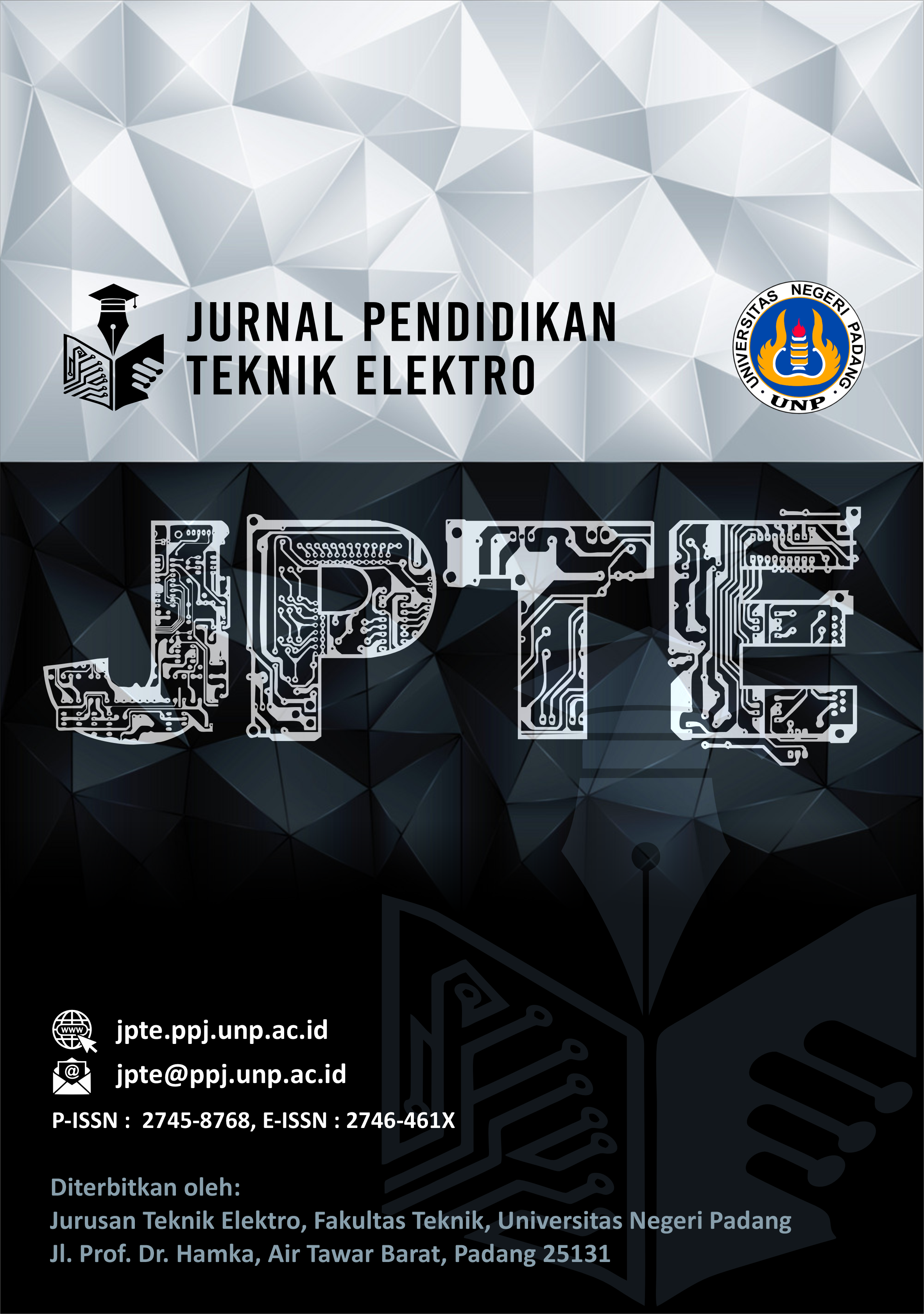Penerapan Model Pembelajaran Student Facilitator and Explaining untuk Meningkatkan Hasil Belajar Siswa Sekolah Menengah Kejuruan
##plugins.themes.academic_pro.article.main##
Abstract
This study aims to analyze the improvement in students' learning outcomes and the percentage of mastery learning after implementing the Student Facilitator and Explaining learning model in the Electrical Installation subject at SMK Negeri 1 Sumatera Barat. This research employs a pre-experimental method with a One-Group Pretest-Posttest design. The research subjects are 30 students of class XI TITL 1 at SMK Negeri 1 Sumatera Barat for the 2024/2025 academic year. Data collection was carried out through pretest and posttest questions that had been validated by experts in the field. Before the implementation of the learning model, students were given a pretest (initial test), while a posttest (final test) was administered after the learning process was completed. The research results indicate that the implementation of the Student Facilitator and Explaining model in the Electrical Installation subject can improve students' learning outcomes. This improvement is evident in the cognitive aspect, as shown by the analysis of pretest and posttest scores using the N-Gain Score formula, which yielded a value of 0.66, categorized as moderate. The percentage of mastery learning also experienced a significant increase, with 90% of students successfully achieving the Minimum Competency Criteria. Thus, the Student Facilitator and Explaining learning model is effective in enhancing students' learning outcomes in the Electrical power Installation subject.
##plugins.themes.academic_pro.article.details##

This work is licensed under a Creative Commons Attribution 4.0 International License.
References
[2] C. Antonietti, A. Cattaneo, and F. Amenduni, “Can teachers’ digital competence influence technology acceptance in vocational education?,” Comput Human Behav, vol. 132, p. 107266, Jul. 2022, doi: https://doi.org/10.1016/J.CHB.2022.107266.
[3] A. Sriyanti and A. U. Asnita, “Effectiveness of Student Facilitator and Explaining Learning Model on Mathematics Learning Outcomes of Junior High School Efektivitas Penerapan Model Pembelajaran Student Facilitator and Explaining terhadap Hasil Belajar Matematika Siswa SMP,” vol. 3, no. 1, pp. 12–23, 2021.
[4] D. T. P. Yanto, Sukardi, M. Kabatiah, H. Zaswita, and O. Candra, “Analysis of Factors Affecting Vocational Students’ Intentions to Use a Virtual Laboratory Based on the Technology Acceptance Model,” International Journal of Interactive Mobile Technologies, vol. 17, no. 12, pp. 94–111, Jun. 2023, doi: 10.3991/ijim.v17i12.38627.
[5] S. P. Amral, S.Pd ; Asmar, hakikat Belajar dan Pembelajaran. Bogor: Guepedia:Bogor, 2020.
[6] D. T. P. Yanto et al., “Evaluating the Practicality of Android-Based Courseware in Enhancing Electrical Circuit Proficiency among Vocational Students,” International Journal of Interactive Mobile Technologies (iJIM), vol. 18, no. 02, pp. 27–42, Jan. 2024, doi: 10.3991/ijim.v18i02.46341.
[7] A. Rahim et al., “Motivasi Belajar dan Hasil Belajar Melalui Model Pembelajaran Kooperatif,” Jawa Tengah : Eureka Media Aksara, pp. 1–23, 2023.
[8] R. F. Ariani, “pengaruh model pembelajaran problem based learning terhadap kemampuan berpikir kritis siswa SD pada muatan IPA,” jurnal ilmiah pendidikan dan pembelajaran, vol. 4(3), pp. 422–432, 2020.
[9] Baidowi, K. Sarjana, R. A. Apsari, D. Novitasari, and N. M. I. Kertiyani, “Tingkat Kemampuan Berpikir Kritis Matematika Siswa Sekolah Menengah Kejuruan,” Evolusi : Journal of Mathematics and Sciences, vol. 5, pp. 95–101, 2021.
[10] D. T. P. Yanto, Ganefri, Sukardi, J. P. Yanto, R. Kurani, and Muslim, “Engineering Students’ Acceptance of Augmented Reality Technology Integrated with E-Worksheet in The Laboratory Learning,” International Journal of Online and Biomedical Engineering (iJOE), vol. 20, no. 03, pp. 39–54, Feb. 2024, doi: 10.3991/ijoe.v20i03.46101.
[11] G. S. Amelya, R. Wati, S. Wahyudi, and A. Setiawan, “Model Pembelajaran Student Facilitator And Explaining Terhadap Peningkatan Kreatifitas Prestasi Belajar Siswa Sekolah Menengah Kejujuruan 1 Rambah,” Jurnal Pendidikan Tambusai, vol. 7, no. 2, pp. 3931–3936, 2023.
[12] Batin Wardah and M. Zainal Arifin, “Penerapan Model Pembelajaran Student Facilitator And Explaining untuk Meningkatkan Motivasi dan Hasil Belajar Siswa XI IPS 2 SMA Negeri 1 Leuwiiliang,” EDUKASIA: Jurnal Pendidikan dan Pembelajaran, vol. 3, no. 3, pp. 709–726, 2022, doi: 10.62775/edukasia.v3i3.185.
[13] Huda, Model-model Pengajaran dan Pembelajaran. Pustaka Pelajar, 2014.
[14] Istarani, 50 Tipe, Strategi dan Teknik Pembelajaran Kooperatif. Medan: Media Persada, 2015.
[15] M. Gompi, N. Bito, and D. R. Isa, “Pengaruh Model Pembelajaran Student Facilitator And Explaining Terhadap Hasil Belajar Sisiwa Pada Materi Bentuk Aljabar,” vol. 06, no. 03, pp. 3287–3295, 2022.
[16] S. N. Telaumbanua, B. Laoli, A. Lahagu, and E. S. Laoli, “Penerapan Model Pembelajaran Student Facilitator and Explaining dalam Meningkatkan Hasil Belajar Siswa pada M.P IPS Terpadu di UPTD SMP Negeri 8 Gunungsitoli,” AKADEMIK: Jurnal Mahasiswa Humanis, vol. 4, no. 3, pp. 1113–1124, 2024, doi: 10.37481/jmh.v4i3.1049.
[17] a. muri Yusuf, Metodologi penelitian. Padang: UNP Press, 2007.
[18] D. T. P. Yanto et al., “Innovative Laboratory Learning: A Study Evaluating the Practicality of Integrated E-Worksheets with Augmented Reality in Electrical Machines Course,” International Journal of Information and Education Technology, vol. 14, no. 7, pp. 996–1005, 2024, doi: 10.18178/ijiet.2024.14.7.2127.
[19] A. Fadila, “Implementasi Model Pembelajaran Student Facilitator And Explaining pada Mata Pelajaran Dasar -Dasar Ketenagalistrikan,” vol. 05, no. 01, pp. 73–82, 2024.
[20] S. Fatimah*, R. G. P. Panjaitan, and E. S. Wahyuni, “Penerapan Model Student Facilitator and Explaining Untuk Meningkatkan Hasil Belajar dan Respon Siswa Kelas XI SMA,” Jurnal IPA & Pembelajaran IPA, vol. 6, no. 3, pp. 300–309, 2022, doi: 10.24815/jipi.v6i3.26866.

